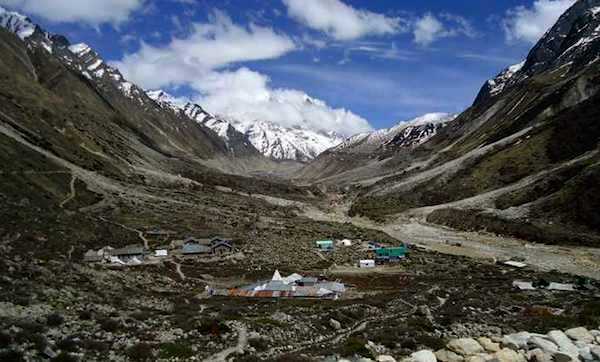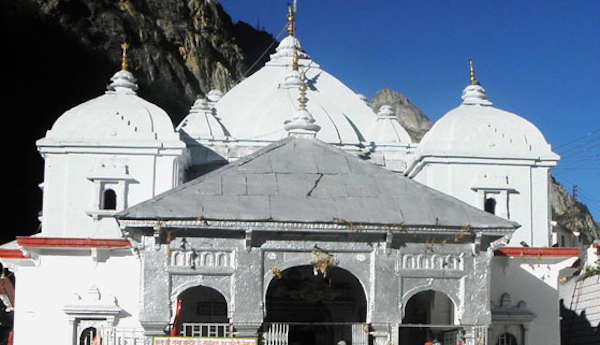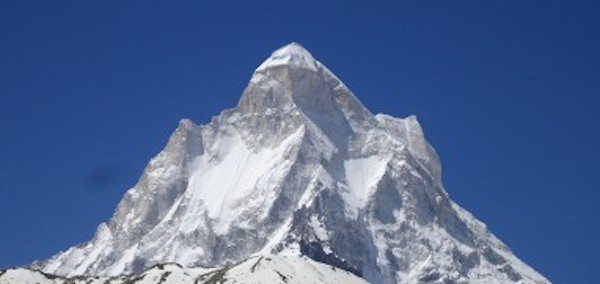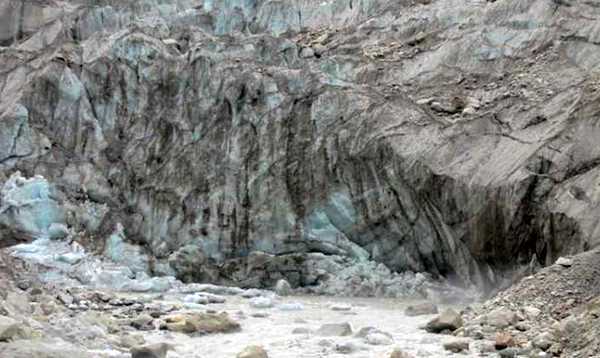
I do not know whether it was the trekker’s delight of high places, the oft-repeated retreat to the hills and forests to rejuvenate the spirit lost in the mire of daily living, or the source of the Ganga that we sought at Gaumukh. Certainly, we had heard and read of other travellers’ experiences – the lone trekker, the devout pilgrim, the wandering sage…and so began the Gaumukh yatra (journey).
We sped through the dusty plains of Uttar Pradesh in the hottest days of summer, to make our first night halt at the popular hill-station, Mussorie, teeming with holiday-makers, a motley crowd with one unifying purport as they promenaded through the Mall – that of determined merriment. The next day’s drive was from Mussorie to Tehri, a bumpy roller-coaster ride minus the thrills.
Beyond Chamba, and almost till Uttarkashi, famous for the ancient temple of Vishwanath, described in the Skand Purana, the soft violet haze of the jacaranda lined road weaves through gentle slopes to the district headquarter town, a cacophony of horns, obnoxious diesel fumes and traffic snarls, from where we scuttled. In our haste we neglected to fill our tanks at the last petrol pump en route to Gangotri, some 200 kms of treacherous hill driving there and back, before petrol would be available again. Of course experience teaches that everything in short supply is abundantly available at a premium.
Unable to get accommodation for the night anywhere, we camped outdoors at Bhatwari, beyond which it is not permissible to drive after dusk. Lying in our sleeping bags, we listened to the Bhagirathi river as it roared below. Counting he stars in the moonless sky, we smelled the damp grass around us, as the fragrance of pine wafted towards us. We tasted the freedom of wide open spaces, promising to return on our way back to relive a moment in time.
In the morning we headed for Gangotri, manoeuvring through 70 kms of narrow winding mountain roads that lie snow-bound much of the year round. With a relatively short distance to cover, we geared ourselves for the trek up to Gaumukh.
On the way, we had lovely refreshing baths in the hot sulphur springs at Gangnani. Here, the choice is between bathing in the open as the steaming water flows directly overhead gushing through a pipe and cooling immediately to a bearable temperature as it touches the atmosphere, or taking a dip in the community bath, segregated for the sexes. The women’s bath was conveniently located by a tea-stall, which provides a bird’s eye view of the bath and an open to sky changing area.
As we climbed upwards towards Gaumukh, we stopped frequently, delighted by the waterfalls as they skipped swiftly from boulder to rock. We were dwarfed by the pine and deodar trees and awed by the Bhagirathi gathering momentum on it’s relentless journey through gorges and gullies.
Early afternoon found us at Gangotri, one of thousands of tourists and pilgrims who come here daily during the couple of months it is accessible. Here the temple of Gangotri stands, dedicated to the goddess Ganga, near the sacred stone where legend has it that King Bhagirathi worshipped Mahadeva. When Ganga first descended to earth from the heavens, Lord Shiva released the waters of the Ganga through the locks of his hair.

The temple here was built by the Gorkha General Amar Singh Thapa in the 18th century, and is situated on the right bank of the Bhagirathi. It is a neat white-washed structure, completely lacking ostentation, like most temples in the Himalayas – a testimony to the simplicity and purity of the people who belong here.
By the late afternoon, the busloads of pilgrims have departed, the priests having performed innumerable ceremonies for the last rites of the dead, and the remote temple town has an air of silent serenity. As dusk settles and icy winds sweep through, the temple bells ring for the evening aarti, performed by the river against the backdrop of the majestic mountains.
I watch the great Ganga in silent awe, as she cascades along with the ingenuous delight of childhood to later rush headlong with the momentum of youth, before she descends from the lap of the Himalayas to quench the thirst of the vast plains of India. As Ganga Ma, absorbing experience and pain, healing and purifying, she matures to become the serene, gently-flowing river filled with the wisdom of ages that surrenders itself to merge with the ocean at the end of her journey.
This then is the Ganga I seek on the trail to Gaumukh, where she emerges from beneath her glacial home, amidst the eternal snows, the abode of the gods. Watched by the mighty peaks of the Bhagirathi sisters, blessed by the awe-inspiring Shivling, that stands remote and splendid, the mighty Ganga is born, christened as Bhagirathi. Standing there, I asked myself, if it was the trekker I acknowledged in myself, or the pilgrim I denied, who sought to reach Gaumukh, deeply revered by the devout.
To answer this question, I had to return here a decade later, and I had to trace the Ganga from Kailash where she was sought, all the way till she merges with the great oceans at Ganga Sagar, near Kapil Muni’s ashram. I spent time on her banks at many different places, in austere sadhana, before I understood what the Ganga can reveal. But that was a different journey, inspired by this darshan of her.
In the early morning, before the sun’s rays slant across the sky, we leave the Forest guest House, where we spent the night. Crossing the bridge, we walk though the tiny, improvised market place and pass the temple to ascend the initial steps from the river. The first eight or ten kms of climb one walks and walks, aware of little else, stepping back into old patterns of walking, till the rhythm of the motion itself propels one forward, and there is time to assimilate the experience. By the time we reach Chirbasa, after crossing a narrow log bridge and scrambling over rocks, I have got rid of the routine mind-set, and returned where I have always belonged, in wide open spaces with a free, unfettered mind.
Sitting and chatting in a make-shift tea-stall at the edge of a birch forest, we have lost all sense of time and purpose. Thereafter the six km trek to Bhojbasa is exhilarating. The snow-capped peaks we have been approaching for days, loom large and splendid over us. The peaks all around are covered with snow – except one, an inexplicable reminder of Peter Matthiessen’s search through the Himalayas armed with the koan, “all the peaks are covered with snow, why is this one bare?”

Walking along the precipitous side of the mountain, looking way below at the Bhagirathi, we climb higher in the rarefied atmosphere as the late afternoon winds rage fiercely. Treading warily over loose stones we remember forever the landslide we cross, with the relentless wind blowing sand and stone, harsh against our faces.
The terrain is rugged and harsh, and the only sign of life against the surrounding snow line are the barren branches of the Bhojpatra trees the bark of which was used to inscribe many ancient manuscripts. We come across the Himalayan whistling thrush, as it sings melodiously. Jet black in color, it is almost indistinguishable in appearance from the cough, also an inhabitant of these parts.
In a clearing in the valley near the river, we spot the comforting sight of solid structures to spend a warm night at the Garhwal Mandal Vikas Nigam rest-house, where we enjoy a simple, piping hot meal.
In the early morning, the skies are a sullen grey as we set off in the cold, damp air towards Gaumukh. Before long, dark ominous clouds and bitter cold gales pre-empt the snowfall to follow. We sit and watch the silent white world from the tented shelter of a tea-stall, half a kilometre from the glacier. As the sky clears marginally, we climb over rocks and boulders to reach a kilometre wide glacier extending over several kilometres. We wait and watch as the sun peeps out intermittently through the drifting snowflakes. We watch the icy waters of the Bhagirathi gushing forth from beneath the Gangotri glacier.

I am momentarily tempted to take a bottle of water from the source of the Ganga, but simultaneously appalled at myself, having long believed that life is reckoned by moments of awareness and not by the memorabilia we desperately cling to. So, I walk lightly on, unfettered.
Returning to Bhojbasa, we spot a herd of Bharal, or Himalayan blue sheep, at a distance. This being a rare treat, much of the rest of the day is spent watching the grazing Bharal. In the late afternoon, there is a fresh snowfall, and in the falling snow we walk in the direction of Gaumukh, and revel in the sheer splendour and beauty of the Himalayas. The sky clears miraculously before sunset, as though nature itself could not resist the glory of the setting sun. What a profusion of colors: the peaks are golden, amber, pink, scarlet in the glow of the setting sun, before the moon shimmers silver streaks over them and the freshly fallen snow around.
Some day, I would return again.

Leave a Reply